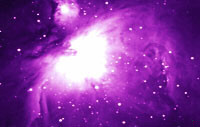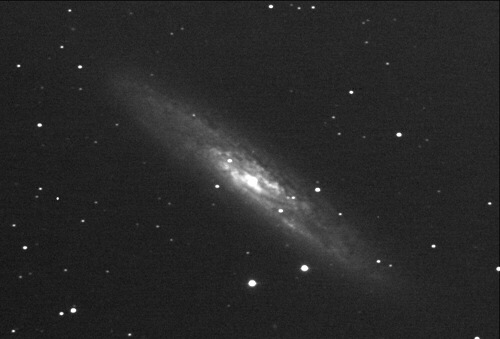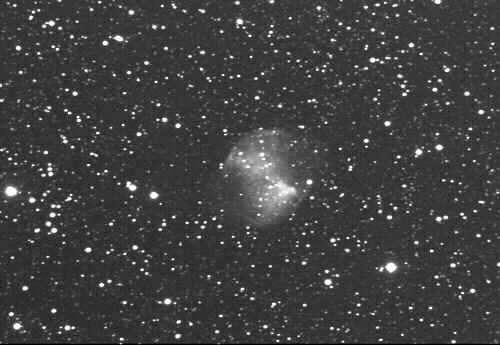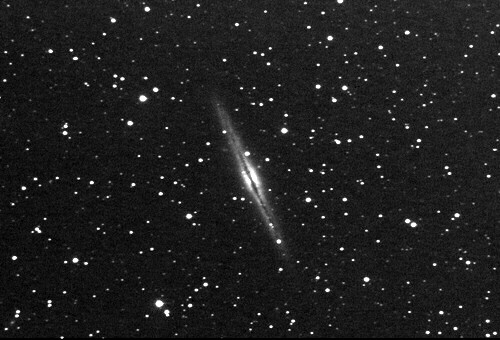
02/01/98 Sky & Telescope By Masi, Gianluca Magazine: Sky & Telescope; February 1998 Section: astro imaging
You don't need big telescopes or the darkest skies to enjoy the benefits digital imaging brings to amateur astronomy.
 CCD cameras are no longer a novelty in the world of amateur astronomy. Around the
globe backyard observers are probing the sky with digital technology, and producing
images that were simply unimaginable only a few years ago. Thanks to magazines like
this one, amateur CCD images are becoming widely known. But readers are often left
with the impression that interesting images require large telescopes and dark skies.
This is because many of the first amateurs to experiment with CCDs were advanced
observers who already owned large telescopes. Nevertheless, as the images here
prove, wonderful results are possible with small telescopes working under
less-than-ideal conditions.
CCD cameras are no longer a novelty in the world of amateur astronomy. Around the
globe backyard observers are probing the sky with digital technology, and producing
images that were simply unimaginable only a few years ago. Thanks to magazines like
this one, amateur CCD images are becoming widely known. But readers are often left
with the impression that interesting images require large telescopes and dark skies.
This is because many of the first amateurs to experiment with CCDs were advanced
observers who already owned large telescopes. Nevertheless, as the images here
prove, wonderful results are possible with small telescopes working under
less-than-ideal conditions.
After gaining experience with traditional deep-sky astrophotography, I began thinking about making the leap to digital imaging. I was immediately confronted with a dilemma. Was it worth getting a CCD camera while still living in a lightpolluted town? Wouldn't it be better to invest in a transportable telescope with a large aperture? I live in Ceccano, Italy, only 90 kilometers (56 miles) south of Rome. Like so many communities today, this town of 25,000 inhabitants has experienced an alarming growth of terrible lighting systems.
 My university engagements prevent me from making frequent trips to dark-sky sites.
As many amateurs know all too well, observing under dark skies presents a host of
difficulties, not the least of which is the time it takes getting to and from a suitable site.
I wanted to observe from my home.
My university engagements prevent me from making frequent trips to dark-sky sites.
As many amateurs know all too well, observing under dark skies presents a host of
difficulties, not the least of which is the time it takes getting to and from a suitable site.
I wanted to observe from my home.
What ultimately persuaded me to purchase a CCD camera was the knowledge that many professional telescopes are experiencing a rebirth thanks to digital detectors. I was convinced the same would happen in my case even though my telescope is a 6-inch f/5 Newtonian reflector and my "observatory" is the roof of my house in the center of the town.
I selected a Santa Barbara Instrument Group ST-7 camera, which has a Kodak KAF-0400 CCD. The telescope is a Vixen Super Polaris R-150S with a German equatorial mounting controlled by an early (1985) version of the Skysensor micro-computer. Both the camera and telescope can be operated from a room below the roof. The camera is very compact and easy to use, and I find the image quality comparable to what I've obtained with gashypersensitized Technical Pan 2415 film.
My CCD exposures are typically about one minute long and show pinpoint star images without having to guide the telescope. I use the camera's track-and-accumulate feature, which automatically aligns and adds together these short exposures, so I can achieve a long effective exposure. In addition to the camera software, I process images with CCDSoft by Software Bisque and Christian Buil's QMiPS32. I also use CCDSoft to control operations of the CCD camera and for image acquisition.
 In the beginning I decided not to image extremely faint objects, fearing they would be
totally drowned by my bright sky. I also developed a plan to reduce the effects of light
pollution without resorting to special filters. A survey of the night sky from my roof
revealed that some directions are darker than others, with the southeastern and
northern sky being the worst. Even on the clearest of nights, the glare here reaches
25 degrees to 30 degrees above the horizon.
In the beginning I decided not to image extremely faint objects, fearing they would be
totally drowned by my bright sky. I also developed a plan to reduce the effects of light
pollution without resorting to special filters. A survey of the night sky from my roof
revealed that some directions are darker than others, with the southeastern and
northern sky being the worst. Even on the clearest of nights, the glare here reaches
25 degrees to 30 degrees above the horizon.
The southwestern and western sky is much better, as is the region around the zenith, where I can sometimes see stars down to 5th magnitude with the unaided eye. On the clearest nights I can trace the Milky Way overhead from Cygnus to Sagittarius. Except for cases of absolute necessity, I avoid imaging objects in the brighter parts of my sky. This means I have to be patient and wait for the right time of night or season of the year for my targets to appear in optimum directions. Although a darker sky would obviously be desirable, I can still record stars of magnitude 18 1/2 with a 25-minute exposure.
Today's sky-simulation software is very helpful when you are planning an observing session. These programs make easy work of determining what objects are currently well placed for imaging. They can also determine when a particular object will be in an ideal part of the sky. I use TheSky. It has a very useful feature that allows me to define a custom horizon. While it was intended to identify obstacles like buildings and trees at a particular observing site, I use it to mark zones of heavy light pollution. I can thus tell at a glance if an object is in the dark part of my sky.
 Pointing the telescope toward a relatively dark region of the sky is not enough to
ensure good results. It is important to limit the direct and indirect light that hits the
instrument, since this illumination always seems to find a path to the CCD detector
with disastrous results. By setting up my telescope at a suitable location on the roof I
can eclipse a particularly obnoxious streetlight with a nearby chimney. Another
possibility is to make a simple shield or enclosure for the telescope from cardboard or
lightweight plywood.
Pointing the telescope toward a relatively dark region of the sky is not enough to
ensure good results. It is important to limit the direct and indirect light that hits the
instrument, since this illumination always seems to find a path to the CCD detector
with disastrous results. By setting up my telescope at a suitable location on the roof I
can eclipse a particularly obnoxious streetlight with a nearby chimney. Another
possibility is to make a simple shield or enclosure for the telescope from cardboard or
lightweight plywood.
I am particularly careful to prevent extraneous light from getting into the telescope around the focuser. Most Newtonian telescopes have openings at the focuser's base. I sealed the openings on my scope with opaque black plastic strips made from a bag that holds photographic enlarging paper. It is also very important to use an extension hood on the front of the telescope similar to the one pictured on page 109 and in the June 1997 issue, page 84. This extension is my fundamental defense against extraneous light. The hood should be as long as possible without vignetting the CCD's field of view. It can be easily constructed from cardboard and laminated with cellophane tape to make it dew resistant. Its inner surface must be fiat black to prevent reflections.
 I suggest that people just starting out with CCDs pick their targets from the Messier
catalog. This list contains more than 100 deep-sky objects that are relatively bright
and easy to observe. These targets are evenly distributed around the sky, so you can
always expect to find a few in prime observing locations on any given night. Among the
best are the spiral galaxies M51 and M104, the globular star cluster M13, and the
diffuse nebulae M42 and M27.
I suggest that people just starting out with CCDs pick their targets from the Messier
catalog. This list contains more than 100 deep-sky objects that are relatively bright
and easy to observe. These targets are evenly distributed around the sky, so you can
always expect to find a few in prime observing locations on any given night. Among the
best are the spiral galaxies M51 and M104, the globular star cluster M13, and the
diffuse nebulae M42 and M27.
Because a typical CCD's field is rather small, it is important to consider angular dimensions of the object being imaged. I use a simple formula to find the field, F, in arc-seconds, of any CCD and telescope:
F = (206,265x)/f,
where the telescope's focal length, f, and the CCD's dimension, x, are expressed in the same units of measurement.
Starting with bright objects like those in the Messier list gives us a good way to evaluate the potential of our imaging system and observing site. Once we develop the techniques needed to capture these objects we can move on to fainter targets, such as those listed in the New General Catalogue of Nebulae and Clusters of Stars (NGC) and the Index Catalogue (IC). Many objects in these compilations rival those in the Messier list, especially when viewed with the digital eye of the CCD.
 I never fail to be impressed when the exposure stops and the images of a new object
appear on my computer's monitor. This is especially true as I gain more experience and
my image-processing techniques improve. Raw images are calibrated in a conventional
manner with dark-frame and flat-field exposures. After this I can sit back and admire
the fruits of my efforts. It is very satisfying to see wispy nebulae, highly structured
galaxies, and star clusters overflowing with distain suns. Only a few years ago no one
would have believed such detailed views could be captured with such a small
telescope under light-polluted skies.
I never fail to be impressed when the exposure stops and the images of a new object
appear on my computer's monitor. This is especially true as I gain more experience and
my image-processing techniques improve. Raw images are calibrated in a conventional
manner with dark-frame and flat-field exposures. After this I can sit back and admire
the fruits of my efforts. It is very satisfying to see wispy nebulae, highly structured
galaxies, and star clusters overflowing with distain suns. Only a few years ago no one
would have believed such detailed views could be captured with such a small
telescope under light-polluted skies.
I employ a variety of image-processing techniques to further enhance my pictures, letting good judgment be my guide. Indeed, the possibilities seem never ending with today's advanced software for personal computers. One technique that I find very useful compensates for any uneven background illumination caused by light pollution. This brightness gradient is more pronounced on wide-field images and is enhanced when the contrast is stretched to show faint nebulosity. Since it is a real feature of the sky and not an artifact of the CCD itself, it is not removed with normal fiat-fielding techniques. I eliminate this gradient by subtracting a frame having a synthetic background.
 These frames are prepared analytically with QMiPS32. The improvement is readily
apparent. I also experiment with unsharp-masking techniques and low- and high-pass
filters to enhance details. The programs I use complement each other and together
provide seemingly limitless possibilities for improving digital images.
These frames are prepared analytically with QMiPS32. The improvement is readily
apparent. I also experiment with unsharp-masking techniques and low- and high-pass
filters to enhance details. The programs I use complement each other and together
provide seemingly limitless possibilities for improving digital images.
In addition to taking beautiful pictures, CCDs offer a chance to make discoveries from our backyards. Amateurs can now easily search for new supernovae, variable stars, and asteroids. Recently I discovered an unknown variable star near M27 on one of my CCD images. I remain a firm supporter of measures to limit the spread of light pollution -- dark-sky locations are priceless. But even from urban locations we can use CCDs to observe the wonders of the night sky.
~~~~~~~~
By Gianluca Masi
An undergraduate student in astrophysics, GIANLUCA MASI became interested in amateur astronomy in 1980. He is a member of the Ulysses Comet Watch Network and maintains a web site at http://www.eurolink.it/comets/. He wishes to thank his firiend and amateur astronomer John W. Johnson for reviewing this article and assisting with its translation.
****** Copyright of the publication is the property of the publisher and the text may not be copied without the express written permission of the publisher except for the inprint of the video screen content or via the print options of the software. Text is intended solely for the use of the individual user.
Copyright of "CCDs, small scopes, and the urban amateur." is the property of Sky & Telescope. Its content may not be copied without the copyright holder's express written permission except for the print or download intended solely for the use of the individual user. Content provided by EBSCO Publishing.
Retrieved via Britannica.com